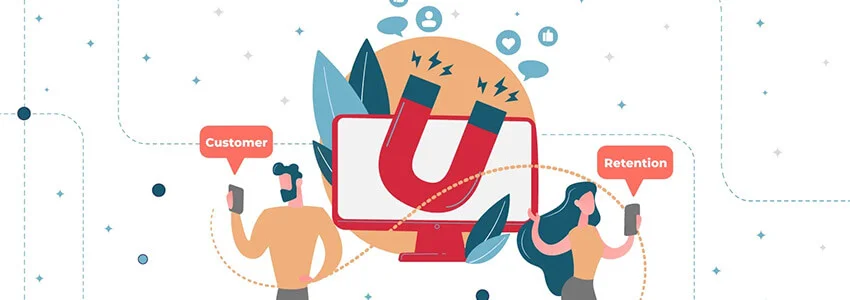Nurturing existing customers is critical to sustainable business success and far outweighs the efforts required to acquire new customers. While lead generation strategies play a role in acquiring new customers, retaining existing customers is critical to long-term profitability. Losing customers can have a significant negative impact on an organisation, leading to missed budgets, a damaged reputation and further customer churn. In fact, the probability of selling to an existing customer is
60-70%, while the chance of acquiring a new prospect is only 5-20%.
This is where customer loyalty management comes into play. The primary goal is to cultivate lasting customer loyalty and increase satisfaction through a series of initiatives. Leveraging existing customer relationships is paramount and minimising churn is essential.
Understanding Customer Loyalty as a Central Business Concept
Customer loyalty is built on the strategies and initiatives that companies use to maintain lasting and positive relationships with their existing customer base. It goes beyond mere transactions and involves creating an environment in which customers feel valued, understood and appreciated. A survey found that 74% of respondents believe that customer loyalty is first and foremost about feeling valued and understood, and that emotional connection is more important than offering discounts or perks.

Why is Customer Loyalty Important for Retention?
In today's dynamic market, customer loyalty is becoming increasingly critical, especially against the backdrop of changing consumer habits due to external events such as the COVID-19 pandemic. According to a study by McKinsey, a significant proportion (73%) of US shoppers who switched brands during the pandemic intend to stay with the new brands. This underlines the impact of external factors on consumer behaviour and the importance of marketing for customer loyalty.
Regardless of size or industry, customer loyalty is crucial for any business. It can be a real success factor that is often underestimated. In fact, 44% of companies focus on customer acquisition, while only 18% focus on customer retention.
‘Repeat business’ (regular customers who buy repeatedly) is often more profitable than constantly acquiring new customers. Acquiring new customers can sometimes be expensive and often tedious. Loyal customers, on the other hand, tend to buy regularly and in larger quantities. This loyalty usually leads to an increase in sales.
Customer retention also provides you with valuable feedback on your products or services. Regular customers can provide useful information on optimisation potential and help you to adapt your offering even better to the needs and wishes of your customers. Satisfied customers are also more likely to recommend a company's products or services on social networks. This form of ‘word of mouth’ is a powerful form of advertising that helps to attract new customers without incurring additional marketing cost
Customer loyalty can offer a significant competitive advantage in retaining your customers, especially in saturated markets. Loyalty to a brand or company can lead to customers remaining loyal to the company despite potentially more favourable offers from competitors.
Customer Loyalty Metrics to Consider when Measuring your Retention

Churn Rate
Imagine your customer base as a revolving door. New customers enter, but unfortunately, some also leave. This "leak" in your customer base is called churn rate. It's a critical metric in customer loyalty because it tells you what percentage of customers stop using your business within a specific timeframe.
Think of churn rate as a ratio that compares how many customers you lose to how many you have overall. Here's the formula broken down:
Churn Rate = (Starting Customers - Ending Customers) / Starting Customers- Starting Customers (AK): This is the total number of customers you had at the beginning of the time period you're measuring (e.g., a month, quarter, or year).
- Ending Customers (EK): This is the total number of customers you have remaining at the end of the same time period.
For example, if you started a month with 100 customers and ended with 85, your churn rate would be:
- Churn Rate = (100 customers - 85 customers) / 100 customers
- Churn Rate = 15 customers / 100 customers
- Churn Rate = 0.15 (or 15%)
What a Churn Rate Tells You
A high churn rate indicates you're losing customers faster than you're gaining new ones. This can hurt your business growth and profitability. A low churn rate, on the other hand, suggests you're effectively retaining customers, which is a positive sign.
Retention Rate

Customer churn rate focuses on the customers you lose, but what about the ones you keep? That's where customer retention rate comes in. It's like the flip side of the churn rate coin, telling you the positive side of the story – how successful you are at retaining customers.
Imagine that same revolving door from the churn rate explanation. Retention rate looks at the opposite side: the percentage of customers who stay with your business over a specific period. It reflects your ability to build customer loyalty and keep them engaged with your products or services.
The calculation for retention rate might look similar to churn, but it focuses on the customers you retain:
Retention Rate = (EK - NC) / AK- Ending Customers (EK): This is the same as before – the total number of customers you have at the end of the measured period.
- New Customers Acquired (NC): This is the number of new customers you gained during the same period.
- Starting Customers (AK): This is still the total number of customers you had at the beginning of the period.
Let's say you started a month with 100 customers, acquired 10 new ones, and ended with 85 customers. Here's the retention rate:
- Retention Rate = (85 customers - 10 customers) / 100 customers
- Retention Rate = 75 customers / 100 customers
- Retention Rate = 0.75 (or 75%)
Understanding Your Retention Rate
A high retention rate signifies your success in keeping customers on board. This translates to recurring revenue, positive brand reputation, and potentially lower customer acquisition costs. Conversely, a low retention rate indicates you need to improve your customer relationships and loyalty programs to prevent churn.
Customer Lifetime Value (CLV): Measuring Your Customer's Worth

While churn and retention rates provide valuable insights into customer movement, they don't tell the whole story.Customer lifetime value (CLV) takes things a step further. It's a metric that estimates the total revenue a single customer brings to your business throughout their entire relationship with your company.
Think of CLV as the big picture of a customer's value. It's not just about the initial purchase they make, but the potential for repeat business, upsells, and referrals over their lifetime as a customer.
Calculating CLV involves some estimation, but here's a simplified formula to get you started:
CLV = Average Purchase Value x Purchase Frequency x Average Customer Lifespan
-
Average Purchase Value: This is the average amount a customer spends per purchase.
-
Purchase Frequency: This represents how often a customer makes a purchase within a specific timeframe (e.g.,monthly, annually).
-
Average Customer Lifespan: This estimates how long, on average, a customer keeps doing business with your company.
Let's say the average customer spends €50 per purchase, buys from you twice a year, and remains a customer for 3 years. Here's a basic CLV calculation:
- CLV = €50/purchase x 2 purchases/year x 3 years
- CLV = €300
Why CLV Matters
Knowing your CLV helps you prioritize customer acquisition strategies. It's often more cost-effective to retain existing high-value customers than to constantly acquire new ones. A high CLV indicates a loyal customer base, which translates to sustainable revenue streams and overall business growth.
Keep in mind: CLV is an estimate, and factors like market changes and customer behavior can influence it. However,it's a valuable tool for understanding the lifetime value of your customers and making informed business decisions.
Net Promoter Score
.webp?width=2000&height=1286&name=NPS_berechnen%20(1).webp)
The Net Promoter Score measures the satisfaction of your customers using a scale rating. The essential question here is how likely a customer is to recommend your brand to others. This is not just about customer satisfaction with a specific product, but rather about the customer's general attitude towards your company. This only requires one question: ‘How likely would you be to recommend this company to friends or colleagues?’ Respondents can answer this with a value from 0 to 10 on a numerical scale. The survey can be conducted by telephone or e-mail, for example. Depending on the answer, they are then categorised into the following groups:
| Points Awarded | Customer Group |
| ✔️ 9 or 10 points awarded | Promoters who rate a company very positively and would recommend it to others. |
| ✔️ 7 or 8 points awarded | Passive or indifferent customers who are neutral towards the company. They are not included in the calculation of the Net Promoter Score. |
| ✔️ 0 or 6 points awarded | Customers who are critical of the company. They could negatively influence other users or potential customers. |
Customer Retention Vs. to Customer Acquisition

As already mentioned, acquiring new customers is often more costly than implementing customer retention measures. The process of acquiring new customers often requires higher marketing and sales expenditure, and the cost of customer acquisition can be up to five times higher. In contrast, ‘repeat customers’ tend to purchase from a company more regularly, which contributes to a more stable revenue stream.
This stability offers greater predictability compared to revenue fluctuations from sporadic new customers. Customers who interact with a company more frequently develop trust and loyalty, making them less susceptible to competing offers.
Over time, they show a greater willingness to overlook minor problems with the company or its products. In addition, repeat customers are more inclined to spread positive word of mouth on social networks than new customers. Recommendations and positive feedback on social media platforms can help expand the customer base without requiring additional marketing efforts. In addition, strong customer relationships help to cushion seasonal or economic fluctuations in business.
Over time, they show a greater willingness to overlook minor problems with the company or its products. In addition, repeat customers are more inclined to spread positive word of mouth on social networks than new customers. Recommendations and positive feedback on social media platforms can help expand the customer base without requiring additional marketing efforts. In addition, strong customer relationships help to cushion seasonal or economic fluctuations in business.
Although new customer acquisition is undoubtedly crucial for business growth, customer retention is equally important for stability, predictability and the overall success of the business. It is advisable to find a balance between customer retention and new customer acquisition that is in line with the company's objectives.
In general, the older or more established a company becomes, the more worthwhile it is to invest in customer retention.
Customer Loyalty Measures
There are various customer loyalty measures that companies can take to build and strengthen long-term relationships with their customers. Here are some effective measures.
Personalization
Personalisation is crucial for customer loyalty as it improves the customer experience and promotes a stronger bond between the customer and the brand. By customising products, services and communications to individual preferences, brands can increase customer retention, satisfaction and loyalty. Providing relevant content, personalised communication and individual product recommendations improves the entire customer journey.
Personalisation not only promotes cross-selling and up-selling opportunities, but also creates an emotional connection that contributes to customer advocacy. Through retention-focused strategies, brands can address specific customer needs, prevent customer churn and encourage long-term loyalty.
Frequent Communication

Regular and targeted communication with customers is crucial for strong customer loyalty. With personalised emails, newsletters or notifications, companies can inform their customers about current offers, new products and exclusive discounts. This regular interaction keeps the brand present and ensures that customers feel valued. Gamification elements, such as interactive digital advent calendars, can further increase customer interaction.
High Level Customer Service
Excellent customer service plays a decisive role in customer loyalty. Quick and effective solutions to customer queries or problems increase trust and satisfaction. Individual support through personalised customer service that responds to specific needs enables companies to build positive emotional connections with their customers.
High-Quality Products and Services
Providing first-class products and services is the foundation for long-term customer loyalty. Customers remain loyal to a brand if they continually have a positive experience with the products on offer.
It's not just the quality of the products that matters, but also the way they are presented and delivered. At W4, we not only offer high-quality products, but our coding experts can also help you create tech-savvy solutions - from engaging websites to powerful web applications.
We understand that user experience is key, and our technology experts can ensure that your digital presence is of the highest standards.
Customer Loyalty Programs

An appealing customer loyalty program takes care of the customer and provides them with what they need: Appreciation, fast support, personalised content, attractive benefits, trust in a brand and much more. If this program is fully set up and meets the customer's needs, they will have a positive experience across all channels - creating a user-friendly customer experience.
The customer loyalty programme and its individual components make it possible to uncover potential for optimising the customer experience. For example, if customer feedback is obtained, this can be implemented directly to improve the customer experience. Furthermore, retention measures such as chatbots, specific mailings, surveys or similar can be evaluated and the results used to optimise the customer experience.
Customers who remain loyal to a company in the long term have the opportunity to continuously experience a positive customer experience and familiarise themselves with the brand. This can create a deeper relationship between the customer and the company.
Cross-Selling and Up-Selling
Targeted cross-selling and up-selling strategies offer customers additional benefits and help to increase sales. Personalised recommendations based on past purchases can guide customers to other relevant products.
An Active Social Media Presence

An active presence and participation in social media enables companies to interact directly with their target group. Customer loyalty and brand loyalty can be strengthened through appealing and personalised content
To Conclude
If you only focus on acquiring new customers and generating leads, you are building on a shaky foundation. The focus should not only be on the growth of a company, but also on its stability through regular customers. The success and planning security of a company is based on loyal customers who buy repeatedly and feel connected to a brand. It is therefore extremely important to look after the customers you have acquired, to gain and retain their trust in the long term in order to generate repeat purchases and further sales. It is often easier and less resource-intensive to promote customer loyalty and thus generate new purchases than to acquire new customers with costly marketing measures.
With a comprehensive customer retention programme, you can retain existing customers in the long term, significantly improve the customer experience and increase your turnover with relatively little effort. Another attractive advantage: it helps you to discover optimisation potential and increase customer satisfaction and loyalty. The personalisation of offers, excellent customer service, customer loyalty programmes, obtaining customer feedback and a positive customer experience are effective strategies for promoting customer retention.
In short: customer retention is of great importance for companies and should be considered at least as important as new customer acquisition. 
This article was originally written in German.






.webp)


